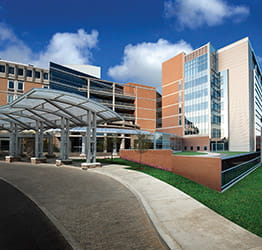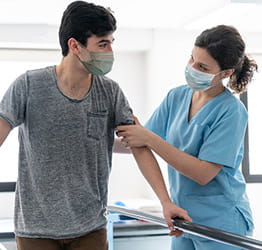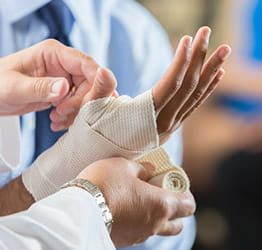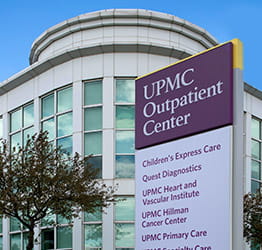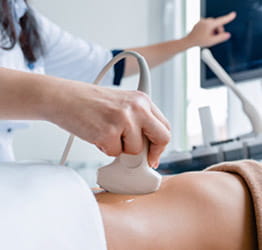What Is Ultrasound-Guided Breast Biopsy?
Ultrasound-guided breast biopsy — also called an ultrasound-guided core needle biopsy — is a minimally invasive outpatient procedure.
During the procedure, a breast radiologist uses ultrasound imaging to guide a needle into a specific area of breast tissue to take a small sample for testing. It is performed to help your care team accurately diagnose breast cancer and other conditions.
Conditions we diagnose with ultrasound-guided breast biopsy
- Atypical ductal hyperplasia.
- Atypical lobular hyperplasia.
- Breast cancer.
- Breast cysts.
- Fibroadenomas.
- Fibroepithelial lesion.
- Flat epithelial atypia.
- Intraductal papilloma.
- Lobular carcinoma-in-situ.
- Microcalcifications.
- Mucocele-like lesion.
- Radial scar.
Why would I need an ultrasound-guided breast biopsy?
Your doctor may recommend an ultrasound-guided breast biopsy if your ultrasound exam shows a suspicious area of breast tissue.
What are the benefits of ultrasound-guided breast biopsy?
Ultrasound-guided breast biopsies do not use radiation, making them a safe option for accurately evaluating a range of breast conditions. Because the procedure targets a precise area of the breast using a small incision when compared to other types of breast biopsy, ultrasound-guided biopsy offers benefits including:
- Less invasive.
- Shorter procedure time.
- Shorter recovery time.
Who’s a candidate for ultrasound-guided breast biopsy?
You may be a candidate for ultrasound-guided breast biopsy if you have a suspicious area of breast tissue and your doctor recommends taking a sample for testing in a lab.
Alternatives to ultrasound-guided breast biopsy
What Are the Risks and Complications of Ultrasound-Guided Breast Biopsy?
Like all medical procedures, ultrasound-guided breast biopsies have some minor risks, including:
- Bleeding — There is a small risk (less than 1 in 100) risk of developing a hematoma (a collection of blood under your skin) that is large enough to cause a lump. This will cause bruising and will eventually go away on its own.
- Bruising — A small amount of bruising is normal at the site of your biopsy and may vary depending on the amount of bleeding during and after your biopsy. However, there should not be any redness near your biopsy site.
- Infection — Infection is very uncommon (less than 1 in 1,000) after core needle breast biopsy, as the procedure is done using sterile techniques. Symptoms of infection include redness and warmth near your biopsy site. If you have symptoms of infection, you should contact the biopsy center or your doctor.
What Should I Expect From Ultrasound-Guided Breast Biopsy?
Before: How to prepare for ultrasound-guided breast biopsy
- Have your healthcare provider enter an order in the UPMC electronic medical record system or provide you with a written prescription to bring with you to your biopsy.
- Stop taking aspirin, aspirin-containing products, and NSAIDs seven days before your biopsy. If you have questions or concerns, please contact the breast center for clarification. You may take an acetaminophen one hour before your procedure to minimize discomfort.
- Contact your doctor if you are taking blood-thinning medication, such as Coumadin®, warfarin, heparin, Pradaxa®, or Plavix®, to find out if you can safely stop the medication before your biopsy procedure.
- Let your care team know if you have a nickel allergy.
On the day of your procedure, arrive 30 minutes before your scheduled procedure time. Be sure to bring your photo ID and health insurance card(s).
You should wear a two-piece outfit (shirt and pants/shorts) and bring a sports bra, if you have one. Wearing a supportive bra after your procedure can minimize breast movement and discomfort.
You should be able to drive home from the hospital after you are discharged.
How long does ultrasound-guided breast biopsy take?
Ultrasound-guided breast biopsy takes about 10 minutes. However, you should plan to be at the breast center for up to two hours.
How painful is an ultrasound-guided breast biopsy?
You will receive an injection of numbing medication that may burn for about 15 seconds. You may feel mild pressure during your ultrasound-guided breast biopsy, but you should not feel any pain.
During your ultrasound-guided breast biopsy
There are several stages of an ultrasound-guided breast biopsy, including:
Imaging
Your radiologist or technologist will obtain ultrasound images of the area to be biopsied and make a small temporary ink mark on your skin.
Local anesthesia
After cleaning your skin, you will receive an injection of numbing medication. You may feel a burning sensation that lasts about 15 seconds while the numbing medication is given. You may feel some pressure during your procedure, but you shouldn't feel any pain.
Tissue sampling
Your radiologist will make a small incision in your skin and insert the biopsy needle into the area of concern using ultrasound guidance. Your radiologist will take several small tissue samples for analysis in the lab.
Marker placement
Your radiologist will place a tiny titanium biopsy clip into the area that was biopsied to mark the area for future breast imaging or surgery. The biopsy clip does not set off metal detectors.
Post-procedure care
Our staff will hold pressure on your incision site for about 10 minutes to make sure the area does not bleed when you get home. Our team will cover your incision with wound closure strips and a bandage. The wound closure strips should be left in place until they fall off on their own after about a week. You will also have a mammogram to confirm that the biopsy marker is placed properly.
How painful is an ultrasound-guided breast biopsy?
You may feel mild pressure or discomfort during your ultrasound-guided breast biopsy, but you will receive local anesthesia and should not feel any pain. You may have mild pain, discomfort, or bruising for 7-10 days after your procedure.
Recovery after ultrasound-guided breast biopsy
You should be able to drive home after your breast biopsy procedure and resume your normal activities within a few hours. You may notice some tenderness, discomfort, or bruising that should get better within 7-10 days.
During your recovery, you should:
- Ask your doctor if it is safe for you to take acetaminophen to manage mild pain or discomfort.
- Apply ice to your breast for 15-20 minutes every two hours for the first 24 hours after your biopsy to reduce bruising and swelling. Switch to warm compresses after 48 hours to manage any discomfort.
- If you have one, wear a sports bra for the first 24 hours after your biopsy.
- Keep your bandage dry and leave it in place for 24 hours after your biopsy. Do not allow your biopsy site to get wet for 24 hours after your biopsy. The wound closure strips on your skin should be left in place and will fall off on their own in about a week.
- Avoid strenuous activity for 24 hours, including pushing, pulling, or lifting more than 10 pounds.
- Ask your doctor when it is safe to resume taking blood-thinning medications, if applicable.
When to call your doctor about complications
Call your doctor right away if you notice signs of infection or complications including:
- Excessive bleeding.
- Redness.
- Swelling.
Next steps after your ultrasound-guided breast biopsy
After your ultrasound-guided breast biopsy, our team will make sure you receive the follow-up care you need.
How will I get my biopsy results?
Our experts understand that waiting for biopsy results can be stressful. It is important to remember that most breast biopsies turn out to be benign (noncancerous). The nurse will call, or make sure your health care provider has called, to inform you of your biopsy results as soon as your results are received from the pathology department. This usually takes 2-4 business days after your biopsy. Your results will immediately go to your patient portal as soon as they are available.
What percentage of ultrasound-guided breast biopsies detect cancer?
About 25-33 percent of ultrasound-guided breast biopsies detect cancer.
What happens if breast cancer is detected?
If your biopsy indicates cancer, you will be referred to a team of UPMC breast cancer experts for treatment. UPMC is nationally recognized and offers the most advanced treatment options available, including surgery, radiation, chemotherapy, and hormonal therapies, along with complementary therapies. Physicians specially trained in the management of breast cancer will review your case with you and develop a personalized treatment plan. Our supportive care team can help you and your loved ones manage the many emotions and questions that may arise throughout the diagnosis, treatment, and recovery process.
What does an 'atypical' result mean?
Your pathologist may report a variety of atypical findings on a core needle biopsy. If you receive an atypical biopsy result, your doctor may recommend that you schedule an appointment at our high-risk breast cancer clinic to discuss risk-reducing strategies.
Atypical ductal hyperplasia (ADH)
Atypical ductal hyperplasia (ADH) is a pre-cancerous condition that occurs when some, but not all, changes resemble breast cancer. If ADH is found, your doctor may recommend surgical excision of a small amount of additional tissue because there is a 35 percent chance that cancer could be present.
Atypical lobular hyperplasia (ALH) and lobular carcinoma in situ (LCIS)
Atypical lobular hyperplasia (ALH) and lobular carcinoma in situ (LCIS) are not cancer, but are markers of increased risk of developing cancer in either breast. If you have ALH, your doctor may recommend six-month follow-up or surgical excision. For LCIS, your doctor may recommend a breast MRI and/or surgical excision of additional tissue at that spot.
What if my biopsy shows benign results?
Your radiologist will need to determine if your imaging results match with the pathology results. Most of the time, you can return to routine screening after a benign result on core needle biopsy. However, a repeat biopsy or surgical excision may be recommended in certain cases.
Why Choose UPMC for Ultrasound-Guided Breast Biopsy?
When you choose UPMC for ultrasound-guided breast biopsy, you will receive:
- Access to advanced imaging technology — Our experts use the latest imaging technology to quickly and accurately diagnose a full range of health conditions.
- Convenient imaging services — Imaging appointments are available at multiple locations with hours that fit your schedule.
- Multidisciplinary care — We partner with breast surgeons, medical oncologists, radiation oncologists, breast reconstructive surgeons, and other medical experts to treat breast cancer and other breast conditions.
By UPMC Editorial Staff. Last reviewed on 2025-08-28.





